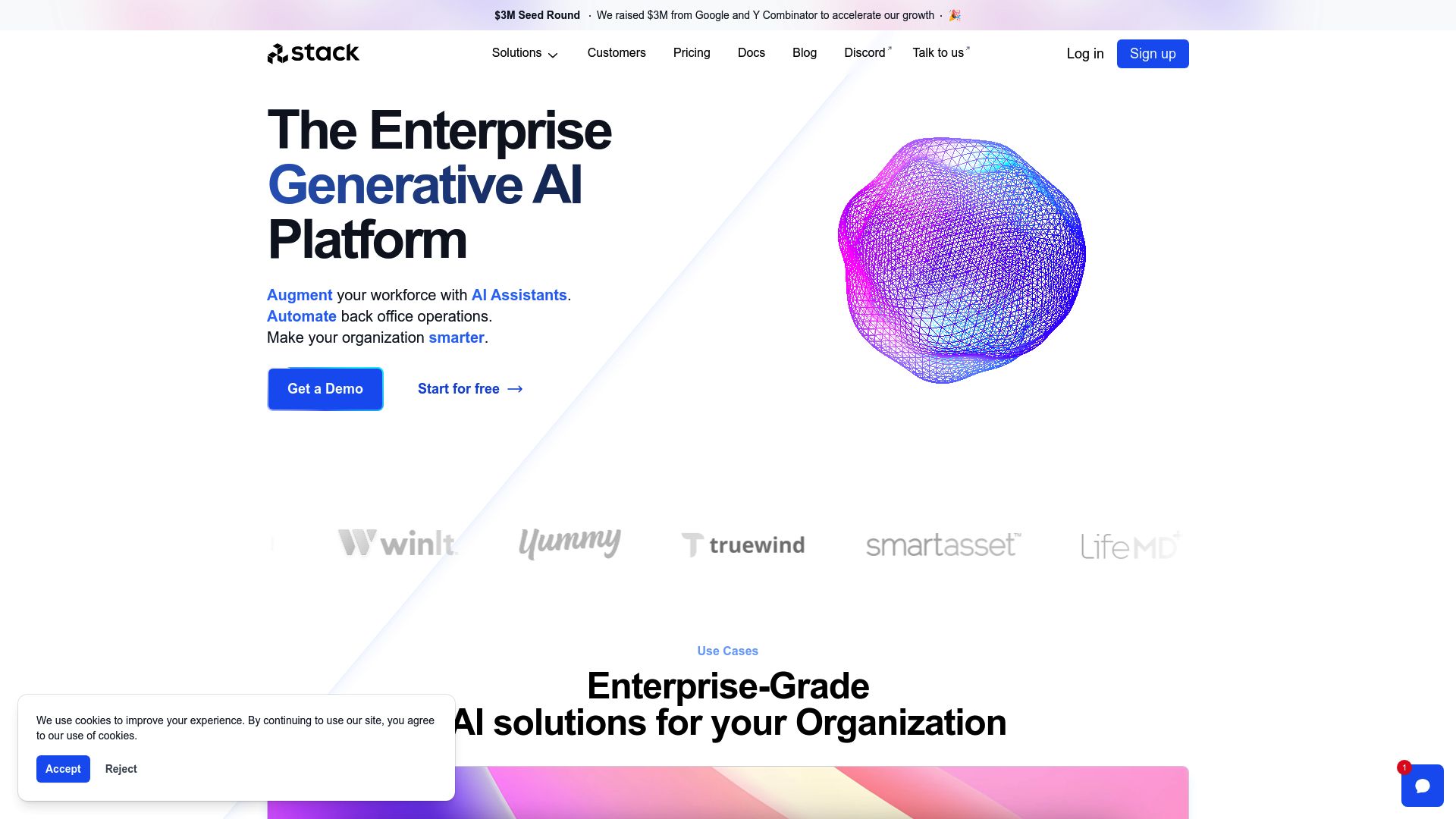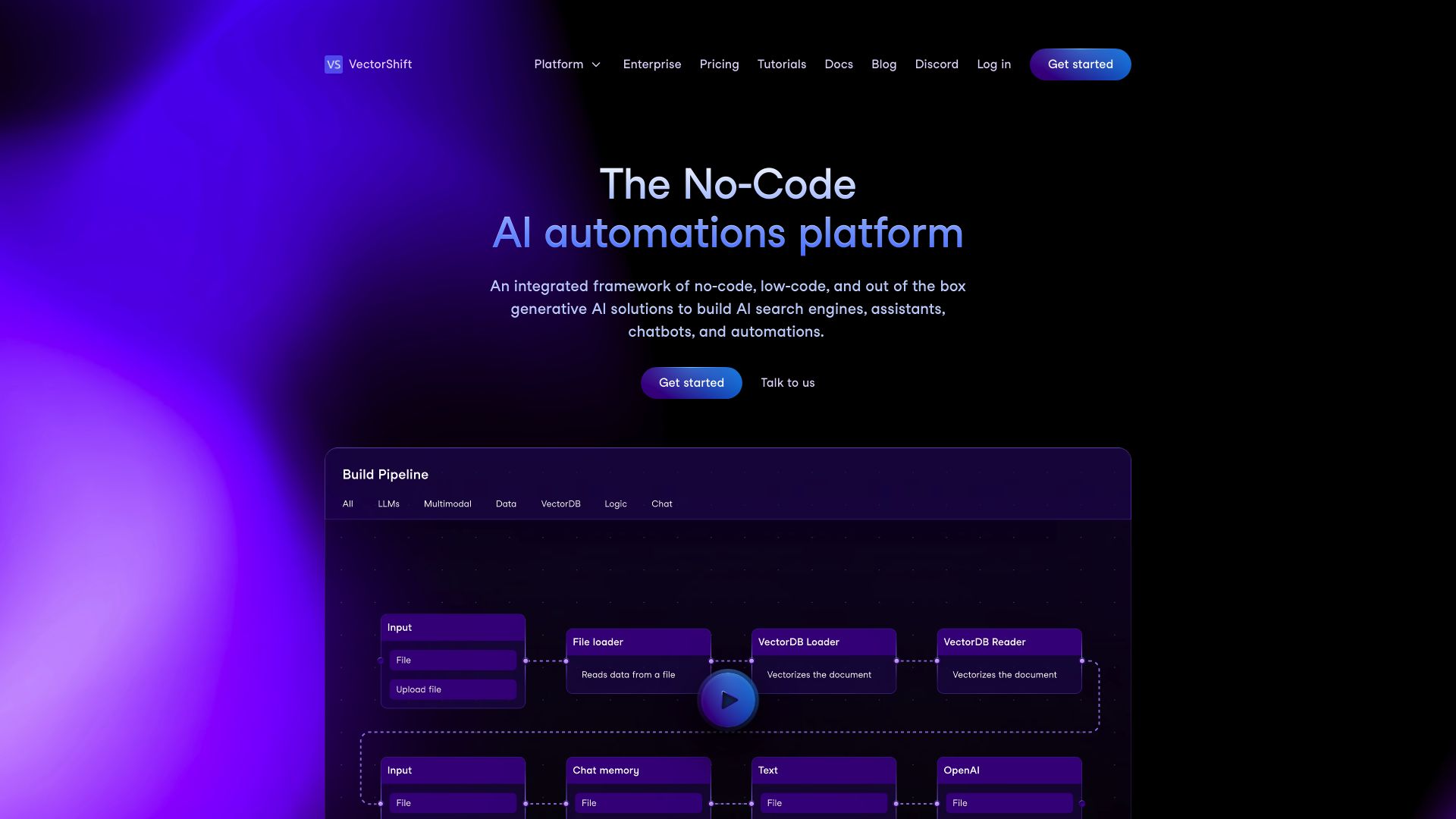Stack AI vs. VectorShift: Comparing AI Automation Platforms
AI-powered workflow automation platforms are transforming how businesses operate, but choosing the right solution can be challenging. This comparison delves into Stack AI vs. VectorShift, two leading platforms in the AI automation space, examining their key features, strengths, and potential drawbacks. We’ll explore how these tools empower users to create custom AI assistants, automate complex processes, and integrate advanced AI capabilities into existing workflows. By the end of this review, you’ll have a clear understanding of how Stack AI and VectorShift stack up against each other—and why SmythOS emerges as the superior choice for businesses seeking to harness the full potential of AI automation.
Stack AI Overview
Stack AI empowers users to create and deploy AI-powered workflows without extensive coding expertise. The platform’s low-code interface enables quick development of custom AI assistants and automated processes, making advanced AI capabilities accessible to a wide range of users.
Stack AI empowers users to create and deploy AI-powered workflows without extensive coding expertise.


Stack AI’s visual builder simplifies the creation of AI workflows through a drag-and-drop interface. Users can leverage pre-built templates for common use cases or design custom solutions tailored to specific business needs. The platform supports both development and production environments, facilitating seamless testing and deployment of AI agents.
Key features of Stack AI include robust memory and context management, enabling AI agents to maintain conversation history and provide more contextually relevant responses. The platform also supports autonomous agents capable of completing tasks independently, as well as multi-agent collaboration for tackling complex problems. Stack AI emphasizes explainability and transparency, providing source citations and context for AI-generated responses.
Stack AI emphasizes explainability and transparency, providing source citations and context for AI-generated responses.
Security remains a top priority for Stack AI, with features such as data encryption, OAuth support, and IP control. The platform complies with industry standards like SOC2, GDPR, and HIPAA, ensuring enterprise-grade protection for sensitive information. Integration capabilities extend to popular AI models, APIs, and data sources, allowing users to create comprehensive AI solutions that seamlessly connect with existing tools and systems.
While Stack AI offers a powerful set of features, users might face challenges in scaling extremely large or complex workflows. Additionally, the platform’s pricing structure may not be suitable for all budget constraints, particularly for smaller organizations or individual developers. Despite these potential limitations, Stack AI provides a robust solution for businesses seeking to harness the power of AI without requiring extensive technical expertise.
VectorShift Overview
VectorShift delivers a robust platform for crafting, prototyping, and managing generative AI workflows and automations. The platform caters to both technical and non-technical users through its dual-interface approach, offering a no-code builder and a code SDK.


VectorShift’s versatility shines through its support for diverse applications, including chatbots, search functionalities, automations, and content creation. Users can centralize and manage various AI-driven tasks within a single ecosystem. The platform’s comprehensive automation capabilities allow for end-to-end workflow automation, scheduled tasks, and trigger-based actions.
VectorShift’s versatility shines through its support for diverse applications, including chatbots, search functionalities, automations, and content creation.
Integration lies at the heart of VectorShift’s design. The platform seamlessly connects with popular data sources like Google Drive, Slack, OneDrive, and Airtable, enabling centralized data management and real-time synchronization across applications. This integration prowess extends to advanced content creation features, allowing users to generate marketing copy, personalized emails, and graphics at scale.
At its core, VectorShift boasts a pipeline dashboard where users create AI workflows from scratch or leverage pre-built templates. This feature streamlines the deployment process, making it accessible for users of varying technical backgrounds. The platform also incorporates a robust knowledge base, enhancing AI accuracy through semantic search capabilities.
VectorShift’s deployment options provide flexibility, allowing users to implement their AI solutions as chatbots, automations, or search functions. Various customization and export options further enhance adaptability, including URL deployment, iFrame integration, and API endpoints.
While VectorShift offers a comprehensive suite of features, potential users should consider their specific needs and technical expertise when evaluating the platform. The dual-interface approach may require a learning curve for some users, and the extent of customization might vary depending on the chosen interface.
Feature Comparison
Stack AI and VectorShift offer robust platforms for AI agent development, but key differences emerge in their core components and security features. Stack AI provides a comprehensive visual builder with drag-and-drop functionality, catering to users with varying technical expertise. VectorShift, while also offering a no-code interface, distinguishes itself with a dual approach that includes a code SDK for more advanced users.
In terms of security, Stack AI emphasizes enterprise-grade protection, complying with SOC2, GDPR, and HIPAA standards. VectorShift’s security features are less prominently highlighted, potentially indicating a gap in this crucial area. Both platforms support data encryption and OAuth, but Stack AI’s explicit mention of IP control gives it an edge in access management.
Regarding core components, Stack AI integrates seamlessly with foundation AI models from providers like OpenAI and Anthropic, as well as Hugging Face models. VectorShift’s capabilities in this area are less clear, potentially limiting its flexibility in leveraging diverse AI models. Stack AI’s robust support for various APIs, including Zapier, and its RPA capabilities provide a wider range of integration options compared to VectorShift. This difference could significantly impact the platforms’ ability to connect with existing tools and automate complex workflows.
Feature Comparison Table
| Stack AI | VectorShift | SmythOS | |
|---|---|---|---|
| CORE FEATURES | |||
| Hosted Agents (Dev, Production) | ✅ | ❌ | ✅ |
| Environments (Dev, Production) | ✅ | ❌ | ✅ |
| Autonomous Agents | ✅ | ❌ | ✅ |
| Explainability & Transparency | ✅ | ❌ | ✅ |
| Debug Tools | ✅ | ❌ | ✅ |
| Multi-Agent Collaboration | ✅ | ❌ | ✅ |
| Audit Logs for Analytics | ✅ | ❌ | ✅ |
| SECURITY | |||
| Constrained Alignment | ❌ | ❌ | ✅ |
| Data Encryption | ✅ | ❌ | ✅ |
| IP Control | ❌ | ❌ | ✅ |
| COMPONENTS | |||
| Huggingface AIs | ❌ | ❌ | ✅ |
| Zapier APIs | ✅ | ❌ | ✅ |
| Classifiers | ✅ | ❌ | ✅ |
| Data Lakes | ✅ | ❌ | ✅ |
| DEPLOYMENT OPTIONS (EMBODIMENTS) | |||
| Staging Domains | ✅ | ❌ | ✅ |
| Production Domains | ✅ | ❌ | ✅ |
| Deploy as Scheduled Agent | ❌ | ✅ | ✅ |
| Deploy as GPT | ✅ | ❌ | ✅ |
| DATA LAKE SUPPORT | |||
| Sitemap Crawler | ❌ | ❌ | ✅ |
| YouTube Transcript Crawler | ❌ | ✅ | ✅ |
Best Alternative to Stack AI and VectorShift
SmythOS emerges as the superior alternative to Stack AI and VectorShift, offering a comprehensive agentic AI automation platform that surpasses its competitors in key areas. Our platform combines ease of use with an extensive feature set, enabling unlimited use cases for businesses of all sizes.
We prioritize user-friendly design without sacrificing power. Our drag-and-drop interface allows users to create complex AI workflows effortlessly, while our pre-built API integrations and templates accelerate development. This approach democratizes AI creation, making advanced capabilities accessible to both technical and non-technical users.
SmythOS shines in its ability to support multi-agent systems. We enable teams of AI agents to collaborate on intricate tasks, enhancing efficiency and scalability.
SmythOS shines in its ability to support multi-agent systems. We enable teams of AI agents to collaborate on intricate tasks, enhancing efficiency and scalability. This feature sets us apart from Stack AI and VectorShift, allowing for more sophisticated and dynamic AI implementations.
Security remains a top priority for SmythOS. We offer robust data encryption, OAuth support, and IP control features, addressing the crucial need for data protection and access management. Our platform also emphasizes explainability and transparency, providing debugging tools and audit logs to ensure AI operations remain accountable and understandable.
With SmythOS, organizations can deploy AI agents across various platforms, including as APIs, webhooks, chatbots, and even GPT models. This versatility, combined with our scalable architecture and extensive integration options, positions SmythOS as the ideal choice for businesses seeking a powerful, flexible, and future-proof AI agent builder.
Conclusion
Stack AI and VectorShift offer powerful platforms for AI agent development, each with unique strengths. Stack AI’s visual builder and enterprise-grade security make it a solid choice for businesses prioritizing ease of use and data protection. VectorShift’s dual-interface approach caters to both technical and non-technical users, providing flexibility in workflow creation.
However, SmythOS emerges as the superior option, combining the best features of both platforms while addressing their limitations. Our drag-and-drop interface rivals Stack AI’s user-friendliness, while our code SDK option matches VectorShift’s flexibility. We excel in scalability, offering seamless deployment across multiple environments and platforms.
Unlike our competitors, SmythOS provides unparalleled integration capabilities, supporting over 300,000 integrations and a wide range of AI models. This extensive ecosystem empowers users to create truly versatile and powerful AI solutions. Our platform also emphasizes security and compliance, matching Stack AI’s enterprise-grade protection while offering more transparency in our security measures compared to VectorShift.
To experience the full potential of AI agent development, we invite you to explore our diverse range of AI-powered agent templates. These templates cover multiple business categories and offer a springboard for your AI initiatives. Ready to start building? Create a free SmythOS account today and join the AI revolution. With our 30-day money-back guarantee, you can discover how SmythOS can transform your workflow risk-free.
Last updated:
Disclaimer: The information presented in this article is for general informational purposes only and is provided as is. While we strive to keep the content up-to-date and accurate, we make no representations or warranties of any kind, express or implied, about the completeness, accuracy, reliability, suitability, or availability of the information contained in this article.
Any reliance you place on such information is strictly at your own risk. We reserve the right to make additions, deletions, or modifications to the contents of this article at any time without prior notice.
In no event will we be liable for any loss or damage including without limitation, indirect or consequential loss or damage, or any loss or damage whatsoever arising from loss of data, profits, or any other loss not specified herein arising out of, or in connection with, the use of this article.
Despite our best efforts, this article may contain oversights, errors, or omissions. If you notice any inaccuracies or have concerns about the content, please report them through our content feedback form. Your input helps us maintain the quality and reliability of our information.
